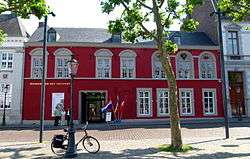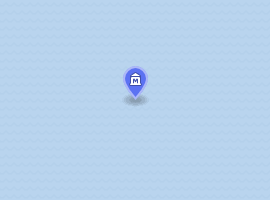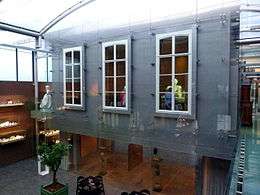Museum aan het Vrijthof
The Museum aan het Vrijthof (previously: Museum Spaans Gouvernement) is a museum of (local) modern art and antiques in Maastricht, Netherlands.
 | |

| |
| Established | 1973 |
|---|---|
| Location | Vrijthof 18, Maastricht, Netherlands |
| Coordinates | 50.5034°N 5.4209°W |
| Director | Erik de Jong |
| Website | www.museumaanhetvrijthof.nl |



History of the building
The museum is housed in the so-called Spanish Government building, one of the oldest non-religious buildings in Maastricht, facing the city's main square, Vrijthof. The building was originally part of the ecclesiastical territory of the chapter of the church of Saint Servatius and was probably built for one of the chapter's canons. In the early 16th century the house was rebuilt and enlarged. At that time the facade on the ground floor was largely blind, except for an arched gateway that led into the courtyard. The three late Gothic windows on the first floor date from this period. Two of them show the pillars of Hercules and the motto of Charles V, Holy Roman Emperor: 'Plus ultra'. The third window, in the middle, carries the symbols of Habsburg power: the double-headed eagle with the coat of arms of Habsburg and Castile.
A little later, an arcade in Liège Renaissance style was added on the side of the courtyard which bears similarity to the architecture of the main courtyard of the Prince-Bishops' Palace in Liège. The colonnade frieze has three sculpted medallions with the portraits of (probably) Charles V, his wife Isabella of Portugal and their son Philip II of Spain, who stayed here at several occasions.[1] It was probably here that Alexander Farnese, Duke of Parma and Governor of the Netherlands, signed the declaration that made William the Silent, leader of the Dutch Revolt, an outlaw. It was during this period that the building acquired its name Spanish Government building (Dutch: Spaans Gouvernement).
In the 18th and 19th centuries the interior of the building was altered several times. It was during this time that extra windows were put in place on the ground floor. In 1766, the Parisian printer and editor Jean-Edmé Dufour bought the building and used it as a print shop. It was from here that many books prohibited in France were smuggled into the country.[2]
In 1913 the building was publicly sold. Part of it was demolished and replaced in 1923 by a building that is now in use as a bank (corner St Jacobstraat). The rest of the building was restored by Victor de Stuers and presented to the city of Maastricht in order to house a local history museum (which did not happen until recently). From 1969-1973, and again from 2010-2012, thorough restorations took place.
The museum
In 1954, the wealthy The Hague based couple Frederik Wagner en Ambrosina de Wit bequeathed their art collection to a foundation based in the city of Maastricht. Since 1973 the Wagner-De Wit collection has been on display in what was then called Museum Spaans Gouvernement. The pavilion room in the courtyard was specifically built to house valuable boiseries from a demolished 18th-century Maastricht mansion. Some of the period rooms decorated in the so-called Liège Régence style, are used for functions.
From 2010 till 2012 the museum closed for renovations and extensions. The renovation included a partial restoration of the originally largely blind facade of the Spanish Government building. The extension consisted of adding a neighbouring building to the museum's exhibition space, as well as roofing over the courtyard. The enlarged museum is now about two and a half times bigger than the old premises. The museum re-opened in March 2012.
Museum aan het Vrijthof is a private museum that receives no government funding. As of 2011, TEFAF has become the main sponsor. In honour of this, the museum has renamed one of its period rooms TEFAF-zaal.
The original collection
The museum's original collection, exhibited until 2014, consists of the Wagner-De Wit bequest and later acquisitions. The collection, brought together by the artistic couple, contained art and artifacts from a wide array of periods and regions, some of which has been discarded by the current directors. The emphasis in the collection was on Dutch and Flemish painting from the 17th century (Dirck van Baburen, Willem de Poorter, Adriaen van de Venne, Cornelius van Poelenburgh, Johannes Lingelbach, Egbert van der Poel, Nicolaes Moeyaert, Nicolaes Berchem, Lodewijk de Vadder, Jacques d'Arthois, Pieter Casteels III) and paintings from the Hague School (Jozef Israëls, Jan Hendrik Weissenbruch, Willem Bastiaan Tholen, George Hendrik Breitner and the brothers Jacob, Matthijs and Willem Maris). The Wagner-De Wit collection also included sculpture from the Middle Ages and Renaissance period, tapestries and furniture from the 16th, 17th and 18th centuries, glass and crystal objects, antique coins, and artifacts from the Far East.
Over the years, the collection has expanded to include Maastricht silver from the 18th century, Maastricht and Liège pistols from the 18th and 19th centuries, and Maastricht painting from the early 20th century. Since 1997 the Bonhomme-Tielens bequest (mainly antique clocks and Maastricht silver) is also part of the museum collection.
After the re-opening in 2012, some rooms were dedicated to important figures from Maastricht history, like the emperor Charles V, the printer Jean-Edmé Dufour, the architect Mathias Soiron, the entrepreneur Petrus Regout and the artist Philippus van Gulpen.
Notes et references
- El felicissimo viaje del muy alto y muy poderoso Príncipe don Phelippe, hijo del emperador don Carlos Quinto Máximo, desde España a sus tierras de la baxa Alemana: con la descripción de todos los Estados de Brabante y Flandes, by Juan Calvete de Estrella (Antwerp, M. Nucio, 1552; reprinted in Madrid, 2001)
- ‘Made by Jean-Edmé Dufour’, on the museum website
Bibliography
- Timmers, J.J.M., Geschiedenis van het Spaans Gouvernement te Maastricht. Maastricht, 1973
External links
| Wikimedia Commons has media related to Museum aan het Vrijthof. |
